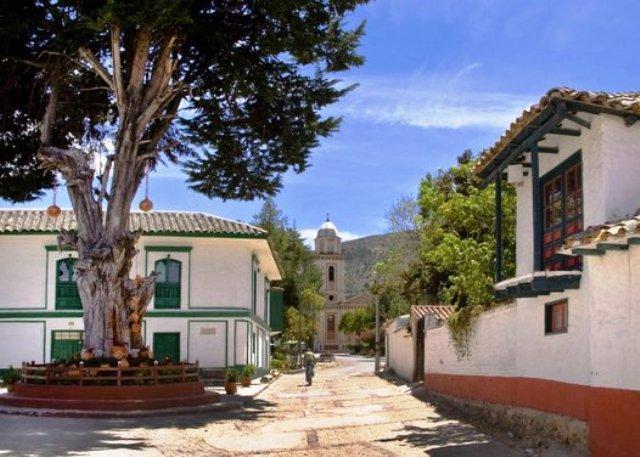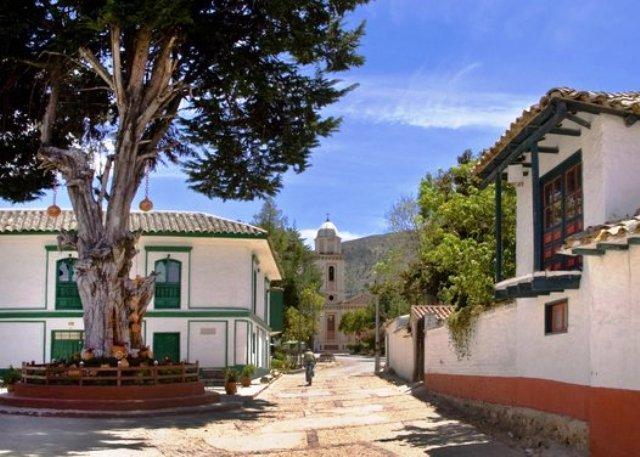Iza, Boyacá, Colombia
Suggest Place to Visit
1753
Track to location with GPS |
 |
Apparently Iza was welcomed by the Spanish population since the time of the Hispanic settlement, in the sixteenth, seventeenth and eighteenth centuries, a fact that implemented adobe constructions, along with wood in doors and windows in addition to its internal structure, the clay tile cooked, brought from Spain but of Greek origin, as well as stone as a base for paths, patios, in the lining of water sources, cloistered patios, among other elements. Its wealth also stands out in terms of mythology where the presence of Bochica is found, the civilizing god who after forming the Salto del Tequendama on the outskirts of Bacatá, present-day Bogotá, with his journey to Iza, set the limits of the Muisca civilization , in the Cundiboyacense highlands. To the east of the municipality in the village of Chiguatá, Chiquí sector, the cave where Bochica lived in his last years is still venerated. Thus, like various archaeological finds, petroglyphs confirm the ancestor of Iza as a pre-Hispanic indigenous site.
The fact that the municipality was only fourteen kilometers from Sogamoso, the capital of the province with an important economic and commercial development, made Iza spend all these years in relative isolation even with a stable or negative rate of population growth, making it preserve its architectural environment, as happened with Santa Cruz de Mompox absorbed by Cartagena de Indias.
The natural environment of the municipality where there are thermal water deposits, is adorned with the artisan industry, in particular El Batán or woven wool or cotton thread. It is said that this trade was taught by Bochica so that the natives, in addition to making warm dresses, could have a decent job as a means of subsistence, since in times prior to the conquest the Indians of the sector bartered blankets, scarves, and others for products of other groups, for salt from the Sabana de Bacatá, agricultural products of the Guanes Indians of present-day Santander, etc.
Since the 1980s, when the ´´Pueblo Más Lindo de Boyacá´´ contest was established in the department, Iza reactivated the conservation of its traditional historical and environmental values and began a process of beautification of its streets, houses, its temple parish church, which preserves the image of the Divine Savior, represented in a miraculous image found in 1748 on a small stone today worshiped as the town's patron. Pedro Alonso Boyacá Fonseca composed the official anthem and directed the formation of the Folk Dance Group; In response to music fans, the municipality opened the Francisco Cristancho Camargo Cultural Center; Young leaders like Dora Moncada C. motivated the community to create the Sergio Camargo Departmental College or Educational Institution on land later donated by Alejandro Mesa Grosso; the Municipal Civic Committee formed two decades ago was strengthened; leaders such as Guillermo Salamanca Turga, Pedro Martínez T., started the regional folk festivals, which in 2008 at the request of the mayor of Victor Hugo López and the Director of Culture Ana Josefa Cristancho institutionalized under the name of the Francisco Colombian Music Festival. Cristancho Camargo.
Iza was graduated in 2000 as ´´Municipality Walking´´ by the Ministry of National Education for guaranteeing education coverage to the entire school-age population. In 2002 in the administration of Emiro Zorro López, the management of the architect specialized in cultural heritage Mariana Patiño Osorio and the Fundación Nido Verde, the national government consecrated Iza as Cultural Heritage of Colombia. In 2006 in the mayor's office of Marcolino Suárez Torres, the embassy of the Republic of Japan donated a Library in its physical structure, equipped with computers and a thousand copies of children's literature and in 2007 the municipal mayor's office and the Pilot University of Colombia published the book ´ ´Iza, the adobe houses´´ by the architects Mariana Patiño Osorio and Rubén Hernández Molina. [6]
In June 2009, Iza hosted the VIII National Meeting of Walkers, although with the support of neighboring towns it received about 1,400 participants, and demonstrated its own hotel capacity. On the occasion of the Bicentennial of Independence 1810-2010, Iza was included in the official commemorative program, since the Liberation Campaign had the support of Izans when Simón Bolívar decreed his Martial Law when he summoned all men under 40 years of age from the Bonza barracks in support of the decisive combats of the Pantano de Vargas on July 25, 1819 and the Boyacá Bridge on the following August 7.
The Group Vigías del Patrimonio Cultural in Iza is coordinated by the Fundación Nido Verde, graduated by the Minister of Culture Paula Marcela Moreno Zapata during her visit to the municipality on June 29, 2009. This group publishes the Informative on Cultural Heritage ´´Arco Iris´ ´. In the future, through the Special Management and Protection Plan, as regulated for the spaces declared Heritage of the National Scope, Iza, with attention to its natural environment, plans to consolidate Cultural Tourism as the main alternative for local development through its enhancement, valuation, protection and diffusion.
Iza is a Colombian municipality located in the province of Sugamuxi in the department of Boyacá. It is located about 90 kilometers east of the city of Tunja. It limits to the north with Firavitoba and Sogamoso, to the east with Sogamoso and Cuitiva, to the west with Pesca and Firavitoba and to the south with Cuitiva.
Iza, with a population that barely exceeds two thousand inhabitants in just over fifty square kilometers of extension, is characterized by a high level of conservation of its historical content which is manifested in some traditions, local toponymy, celebrations and trades such as the fabric in cotton and wool, using practices and looms of medieval Spain, as well as in its colonial architecture established on a typically indigenous layout of its streets, the main aspect that its declaration as an Asset of Cultural Interest in the National Scope meant, for the Ministry of Culture of Colombia in 2002.
Iza's name comes from the Chibcha word Iza, which means night. Although in 1895 the name of the town was changed to Santa Isabel, because according to the Spanish dictionary the word iza meant concubine, its inhabitants kept the traditional name. The municipality is also known as ´´Nido Verde de Boyacá´´, a name given by Professor Manuel Ancizar, who around 1850 toured the region as a participant in the Chorographic Commission led by engineer Agustín Codazzi. In his work ´´Peregrination of Alpha through the northern provinces of La Nueva Granada in 1850-1851´´, Ancizar refers to Iza as a green nest in allusion to the willows, alders, chicalás and other vegetation that gave, as still today, a natural environment in the urban center
The main factors of economic income for Iza are agriculture and mining. Within the mining exploitation coal and pozzolana stand out.
In Iza you can do long or short hikes through mountains such as visiting the Alto de Vita located to the west of the municipality from where you can see several neighboring towns and admire the valley in its majestic fullness, including a visit to our church where we can visit the divine Salvador, as a religious monument, go by mountains or flat sites, by mountain bike, plane, slopes, horseback riding, equine therapy, swimming, very close you will find sulfur mud deposits in which you can take mud baths. Excellent for the skin.
Comments
We don´t have yet any comments about:
Iza
Iza
Be the first to leave a comment as it is very important to inform other people
Outros locais a visitar
Within a radius of 20 km from:Iza
Iza |
| 0,0 Km |
 |
Hotel reservation near Iza within a radius of 20 km
Why to book with ROTAS TURISTICAS
The best prices
Our partnerships with the world´s largest operators offer research on the best market prices.
More options
At Rotas Turisticos you can book the hotel, buy the air ticket, book the transfer from the airport to the hotel and vice versa, book the local excursions, rent the car, take travel insurance and consult the places to visit and where to go.
Holiday Tips & Destinations
Hundreds of holiday destinations with all the options that allow you to easily choose the destination that best suits your dream vacation.
ROTAS TURISTICAS
Links






